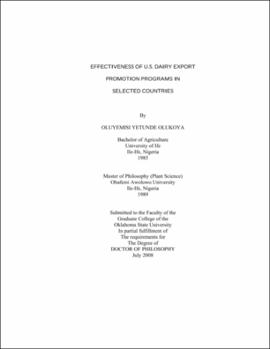| dc.contributor.advisor | Henneberry, Shida | |
| dc.contributor.author | Olukoya, Oluyemisi Yetunde | |
| dc.date.accessioned | 2013-11-26T08:22:03Z | |
| dc.date.available | 2013-11-26T08:22:03Z | |
| dc.date.issued | 2008-07 | |
| dc.identifier.uri | https://hdl.handle.net/11244/6529 | |
| dc.description.abstract | Scope and Method of Study: The purpose of this study is to estimate the impact of U.S. dairy export promotion expenditures and determine the impacts of other factors affecting import demand for source differentiated whey, cheese, and nonfat dry milk (NFDM) in selected countries, using different versions of the differential demand systems. A model selection test was performed by using a general model that nests four demand systems: Rotterdam, Almost Ideal Demand System (AIDS), Central Bureau of Statistics (CBS), and National Bureau of Research (NBR) in selecting the model which best explains consumer allocation decisions. Tests for symmetric weak separability among the dairy products in each country were conducted. | |
| dc.description.abstract | Findings and Conclusions: The dairy products are estimated separately, based on the results of separability tests. The Rotterdam model best fits the import demand for cheese and NFDM in Japan; whey and NFDM in Thailand; cheese in South Korea; and whey and NFDM in Mexico while the CBS is used in estimating import demand for cheese and whey in South Korea; and cheese and whey in Mexico. The U.S. might be able to use price as an advantage in competing with other suppliers of cheese in South Korea and whey in Mexico. The U.S. has the most elastic expenditure elasticity in the whey import markets in South Korea, and Thailand; and in the NFDM import market in Thailand. There is a diverse degree of significant substitutability and complementarily relationships among the different sources of imports. Demand for U.S. dairy products appear to be non-responsive to U.S. dairy export promotion efforts in all the markets studied, with the exception of the South Korean cheese market. The decreasing marginal returns to cheese promotion expenditures in South Korea calls for caution in the allocation of promotion expenditures in this market. Low levels of promotion expenditures or ineffective allocation of funds to promotion activities could have accounted for non responsiveness of these markets to the U.S. dairy export promotion expenditures. Seasonality tends to play a role in the import demand for these dairy products. | |
| dc.format | application/pdf | |
| dc.language | en_US | |
| dc.rights | Copyright is held by the author who has granted the Oklahoma State University Library the non-exclusive right to share this material in its institutional repository. Contact Digital Library Services at lib-dls@okstate.edu or 405-744-9161 for the permission policy on the use, reproduction or distribution of this material. | |
| dc.title | Effectiveness of U.S. dairy export promotion programs in selected countries | |
| dc.contributor.committeeMember | Epplin, Francis | |
| dc.contributor.committeeMember | Chung, Chanjin | |
| dc.contributor.committeeMember | Applegate, Michael | |
| osu.filename | Olukoya_okstate_0664D_2837.pdf | |
| osu.accesstype | Open Access | |
| dc.type.genre | Dissertation | |
| dc.type.material | Text | |
| dc.subject.keywords | export promotion | |
| dc.subject.keywords | dairy | |
| dc.subject.keywords | cheese | |
| dc.subject.keywords | whey | |
| dc.subject.keywords | nonfat dry milk | |
| thesis.degree.discipline | Agricultural Economics | |
| thesis.degree.grantor | Oklahoma State University | |
